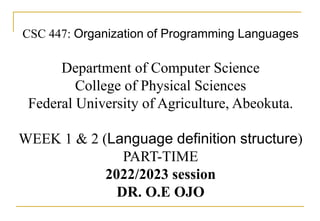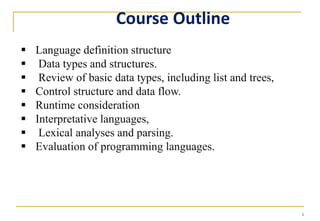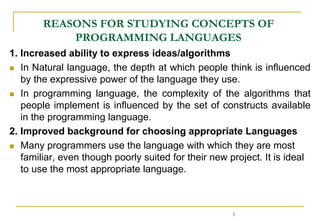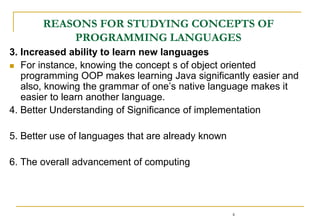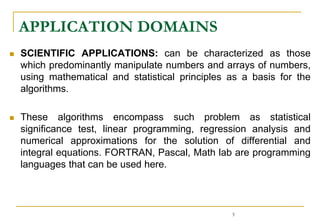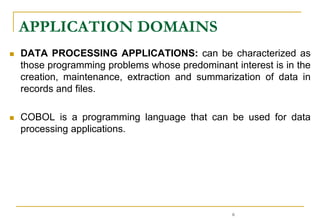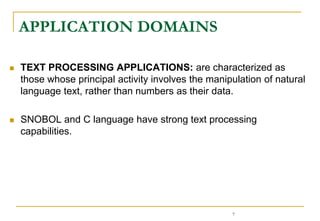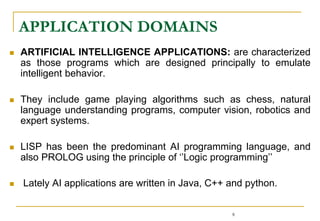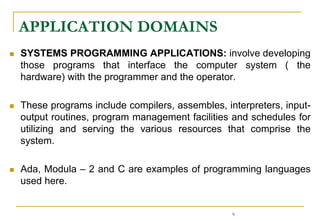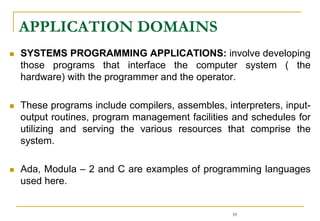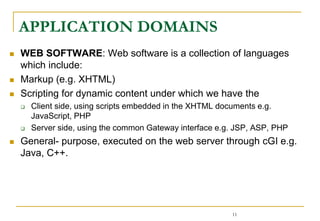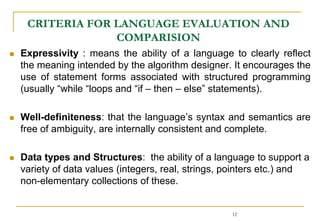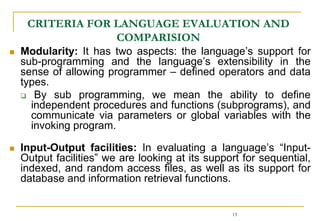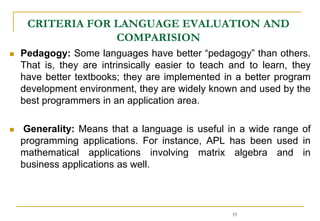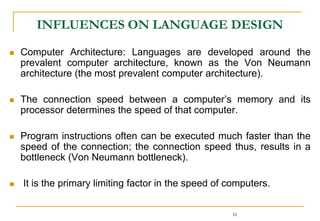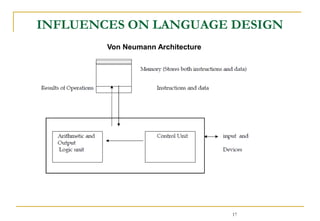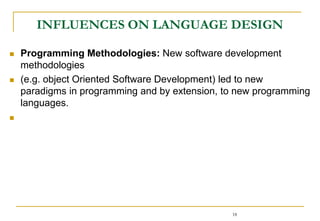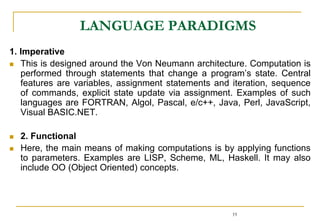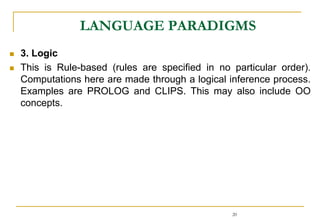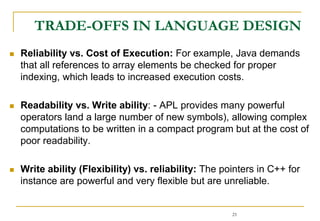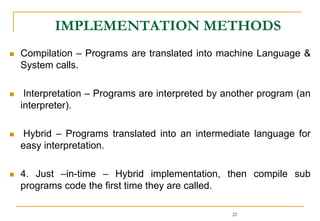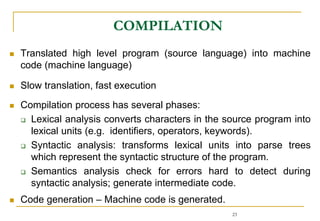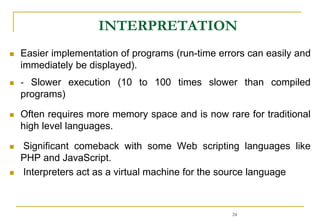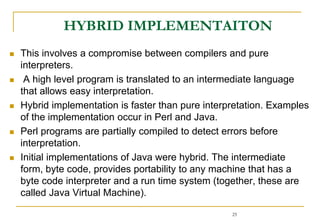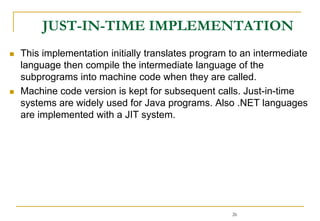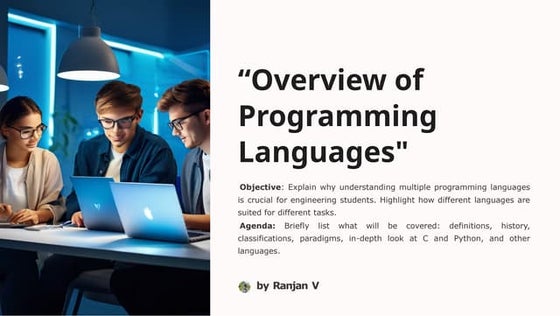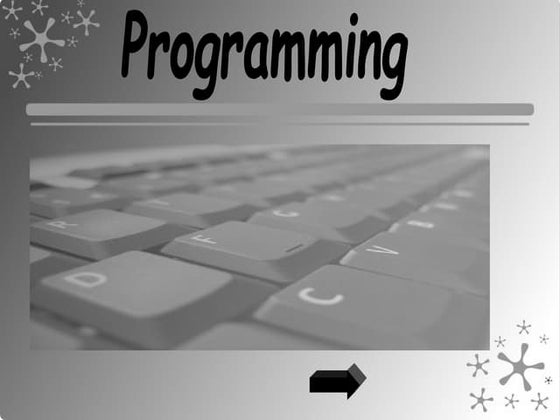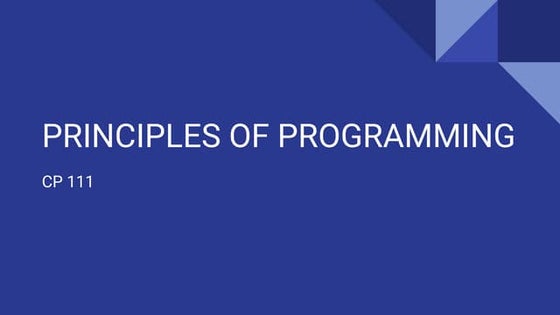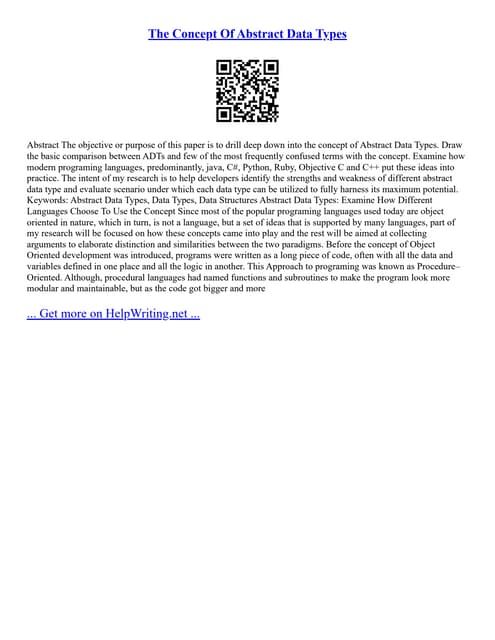CSCorganization of programming languages
- 1. CSC 447: Organization of Programming Languages Department of Computer Science College of Physical Sciences Federal University of Agriculture, Abeokuta. WEEK 1 & 2 (Language definition structure) PART-TIME 2022/2023 session DR. O.E OJO
- 2. Course Outline ï§ Language definition structure ï§ Data types and structures. ï§ Review of basic data types, including list and trees, ï§ Control structure and data flow. ï§ Runtime consideration ï§ Interpretative languages, ï§ Lexical analyses and parsing. ï§ Evaluation of programming languages. 2
- 3. REASONS FOR STUDYING CONCEPTS OF PROGRAMMING LANGUAGES 1. Increased ability to express ideas/algorithms ïź In Natural language, the depth at which people think is influenced by the expressive power of the language they use. ïź In programming language, the complexity of the algorithms that people implement is influenced by the set of constructs available in the programming language. 2. Improved background for choosing appropriate Languages ïź Many programmers use the language with which they are most familiar, even though poorly suited for their new project. It is ideal to use the most appropriate language. 3
- 4. REASONS FOR STUDYING CONCEPTS OF PROGRAMMING LANGUAGES 3. Increased ability to learn new languages ïź For instance, knowing the concept s of object oriented programming OOP makes learning Java significantly easier and also, knowing the grammar of oneâs native language makes it easier to learn another language. 4. Better Understanding of Significance of implementation 5. Better use of languages that are already known 6. The overall advancement of computing 4
- 5. APPLICATION DOMAINS ïź SCIENTIFIC APPLICATIONS: can be characterized as those which predominantly manipulate numbers and arrays of numbers, using mathematical and statistical principles as a basis for the algorithms. ïź These algorithms encompass such problem as statistical significance test, linear programming, regression analysis and numerical approximations for the solution of differential and integral equations. FORTRAN, Pascal, Math lab are programming languages that can be used here. 5
- 6. APPLICATION DOMAINS ïź DATA PROCESSING APPLICATIONS: can be characterized as those programming problems whose predominant interest is in the creation, maintenance, extraction and summarization of data in records and files. ïź COBOL is a programming language that can be used for data processing applications. 6
- 7. APPLICATION DOMAINS ïź TEXT PROCESSING APPLICATIONS: are characterized as those whose principal activity involves the manipulation of natural language text, rather than numbers as their data. ïź SNOBOL and C language have strong text processing capabilities. 7
- 8. APPLICATION DOMAINS ïź ARTIFICIAL INTELLIGENCE APPLICATIONS: are characterized as those programs which are designed principally to emulate intelligent behavior. ïź They include game playing algorithms such as chess, natural language understanding programs, computer vision, robotics and expert systems. ïź LISP has been the predominant AI programming language, and also PROLOG using the principle of ââLogic programmingââ ïź Lately AI applications are written in Java, C++ and python. 8
- 9. APPLICATION DOMAINS ïź SYSTEMS PROGRAMMING APPLICATIONS: involve developing those programs that interface the computer system ( the hardware) with the programmer and the operator. ïź These programs include compilers, assembles, interpreters, input- output routines, program management facilities and schedules for utilizing and serving the various resources that comprise the system. ïź Ada, Modula â 2 and C are examples of programming languages used here. 9
- 10. APPLICATION DOMAINS ïź SYSTEMS PROGRAMMING APPLICATIONS: involve developing those programs that interface the computer system ( the hardware) with the programmer and the operator. ïź These programs include compilers, assembles, interpreters, input- output routines, program management facilities and schedules for utilizing and serving the various resources that comprise the system. ïź Ada, Modula â 2 and C are examples of programming languages used here. 10
- 11. APPLICATION DOMAINS ïź WEB SOFTWARE: Web software is a collection of languages which include: ïź Markup (e.g. XHTML) ïź Scripting for dynamic content under which we have the ï± Client side, using scripts embedded in the XHTML documents e.g. JavaScript, PHP ï± Server side, using the common Gateway interface e.g. JSP, ASP, PHP ïź General- purpose, executed on the web server through cGI e.g. Java, C++. 11
- 12. CRITERIA FOR LANGUAGE EVALUATION AND COMPARISION ïź Expressivity : means the ability of a language to clearly reflect the meaning intended by the algorithm designer. It encourages the use of statement forms associated with structured programming (usually âwhile âloops and âif â then â elseâ statements). ïź Well-definiteness: that the languageâs syntax and semantics are free of ambiguity, are internally consistent and complete. ïź Data types and Structures: the ability of a language to support a variety of data values (integers, real, strings, pointers etc.) and non-elementary collections of these. 12
- 13. CRITERIA FOR LANGUAGE EVALUATION AND COMPARISION ïź Modularity: It has two aspects: the languageâs support for sub-programming and the languageâs extensibility in the sense of allowing programmer â defined operators and data types. ï± By sub programming, we mean the ability to define independent procedures and functions (subprograms), and communicate via parameters or global variables with the invoking program. ïź Input-Output facilities: In evaluating a languageâs âInput- Output facilitiesâ we are looking at its support for sequential, indexed, and random access files, as well as its support for database and information retrieval functions. 13
- 14. CRITERIA FOR LANGUAGE EVALUATION AND COMPARISION ïź Portability: A language which has âportabilityâ is one which is implemented on a variety of computers. That is, its design is relatively âmachine â independentâ. Languages which are well- defined tend to be more portable than others. ïź Efficiency: An âefficientâ language is one which permits fast compilation and execution on the machines where it is implemented. Traditionally, FORTRAN and COBOL have been relatively efficient languages in their respective application areas. 14
- 15. CRITERIA FOR LANGUAGE EVALUATION AND COMPARISION ïź Pedagogy: Some languages have better âpedagogyâ than others. That is, they are intrinsically easier to teach and to learn, they have better textbooks; they are implemented in a better program development environment, they are widely known and used by the best programmers in an application area. ïź Generality: Means that a language is useful in a wide range of programming applications. For instance, APL has been used in mathematical applications involving matrix algebra and in business applications as well. 15
- 16. INFLUENCES ON LANGUAGE DESIGN ïź Computer Architecture: Languages are developed around the prevalent computer architecture, known as the Von Neumann architecture (the most prevalent computer architecture). ïź The connection speed between a computerâs memory and its processor determines the speed of that computer. ïź Program instructions often can be executed much faster than the speed of the connection; the connection speed thus, results in a bottleneck (Von Neumann bottleneck). ïź It is the primary limiting factor in the speed of computers. 16
- 17. INFLUENCES ON LANGUAGE DESIGN 17 Von Neumann Architecture
- 18. INFLUENCES ON LANGUAGE DESIGN ïź Programming Methodologies: New software development methodologies ïź (e.g. object Oriented Software Development) led to new paradigms in programming and by extension, to new programming languages. ïź 18
- 19. LANGUAGE PARADIGMS 1. Imperative ïź This is designed around the Von Neumann architecture. Computation is performed through statements that change a programâs state. Central features are variables, assignment statements and iteration, sequence of commands, explicit state update via assignment. Examples of such languages are FORTRAN, Algol, Pascal, e/c++, Java, Perl, JavaScript, Visual BASIC.NET. ïź 2. Functional ïź Here, the main means of making computations is by applying functions to parameters. Examples are LISP, Scheme, ML, Haskell. It may also include OO (Object Oriented) concepts. 19
- 20. LANGUAGE PARADIGMS ïź 3. Logic ïź This is Rule-based (rules are specified in no particular order). Computations here are made through a logical inference process. Examples are PROLOG and CLIPS. This may also include OO concepts. 20
- 21. TRADE-OFFS IN LANGUAGE DESIGN ïź Reliability vs. Cost of Execution: For example, Java demands that all references to array elements be checked for proper indexing, which leads to increased execution costs. ïź Readability vs. Write ability: - APL provides many powerful operators land a large number of new symbols), allowing complex computations to be written in a compact program but at the cost of poor readability. ïź Write ability (Flexibility) vs. reliability: The pointers in C++ for instance are powerful and very flexible but are unreliable. 21
- 22. IMPLEMENTATION METHODS ïź Compilation â Programs are translated into machine Language & System calls. ïź Interpretation â Programs are interpreted by another program (an interpreter). ïź Hybrid â Programs translated into an intermediate language for easy interpretation. ïź 4. Just âin-time â Hybrid implementation, then compile sub programs code the first time they are called. 22
- 23. COMPILATION ïź Translated high level program (source language) into machine code (machine language) ïź Slow translation, fast execution ïź Compilation process has several phases: ï± Lexical analysis converts characters in the source program into lexical units (e.g. identifiers, operators, keywords). ï± Syntactic analysis: transforms lexical units into parse trees which represent the syntactic structure of the program. ï± Semantics analysis check for errors hard to detect during syntactic analysis; generate intermediate code. ïź Code generation â Machine code is generated. 23
- 24. INTERPRETATION ïź Easier implementation of programs (run-time errors can easily and immediately be displayed). ïź â Slower execution (10 to 100 times slower than compiled programs) ïź Often requires more memory space and is now rare for traditional high level languages. ïź Significant comeback with some Web scripting languages like PHP and JavaScript. ïź Interpreters act as a virtual machine for the source language 24
- 25. HYBRID IMPLEMENTAITON ïź This involves a compromise between compilers and pure interpreters. ïź A high level program is translated to an intermediate language that allows easy interpretation. ïź Hybrid implementation is faster than pure interpretation. Examples of the implementation occur in Perl and Java. ïź Perl programs are partially compiled to detect errors before interpretation. ïź Initial implementations of Java were hybrid. The intermediate form, byte code, provides portability to any machine that has a byte code interpreter and a run time system (together, these are called Java Virtual Machine). 25
- 26. JUST-IN-TIME IMPLEMENTATION ïź This implementation initially translates program to an intermediate language then compile the intermediate language of the subprograms into machine code when they are called. ïź Machine code version is kept for subsequent calls. Just-in-time systems are widely used for Java programs. Also .NET languages are implemented with a JIT system. 26
Editor's Notes
- #2: 1
